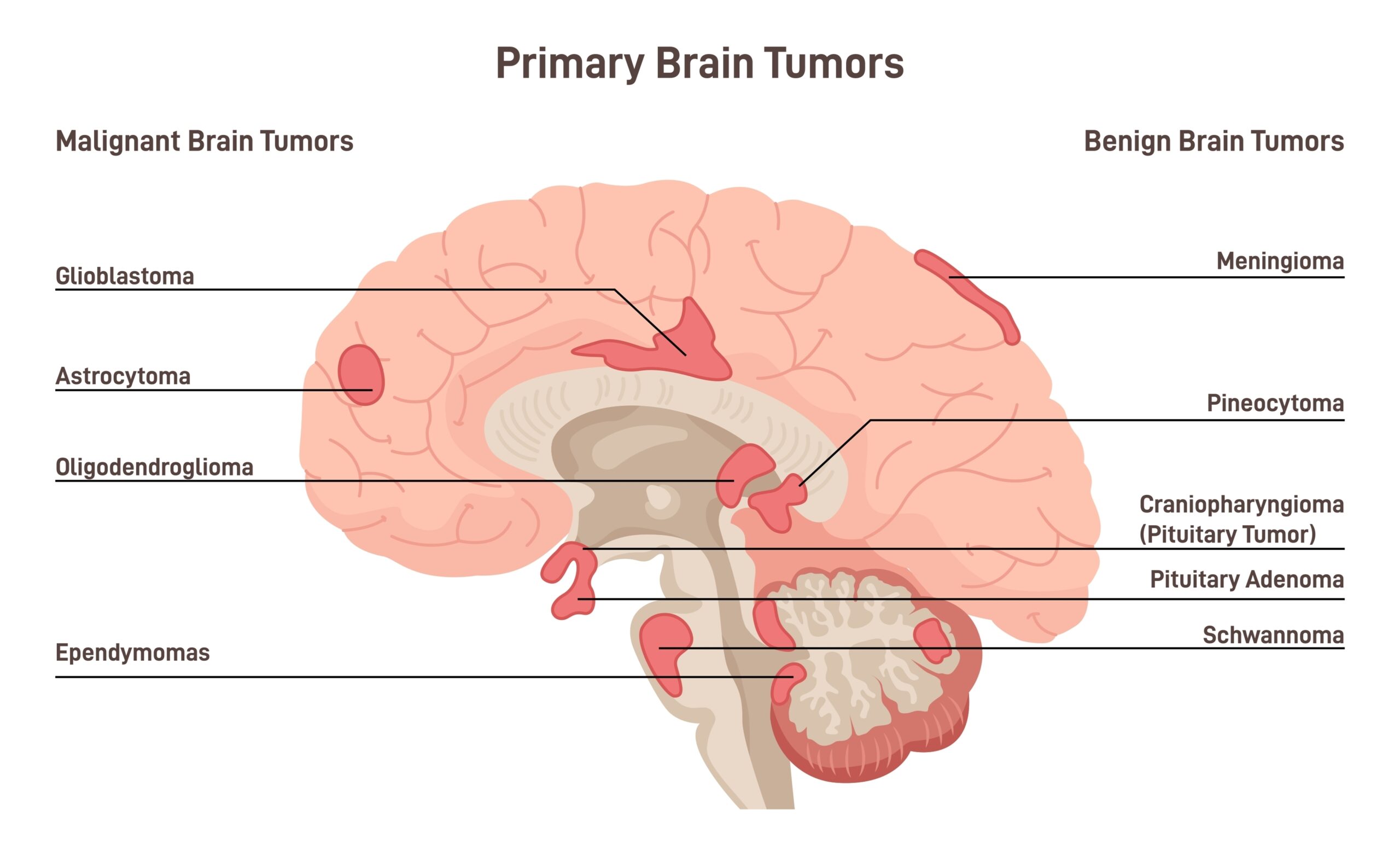A brain tumor is a mass of cells developing in or close to the brain. It may develop primarily in the brain or be metastases from cancer in another part of the body. There are many different types of brain tumors, with the most common ones being gliomas (tumors of the brain supporting tissue) and meningiomas (tumors arising from the membrane layers covering the brain).
Brain tumors can be either cancerous or noncancerous (benign). But even the benign ones can be a problem if they get too big and push on the brain. Some tumors grow quickly, and some grow slowly. Slow-growing tumors might not cause any problems at first. What problems you might have depends on where the tumor is in the brain. You might have trouble seeing, get headaches, have seizures, find it hard to hear, feel sick to your stomach, or throw up.

Brain tumors can be divided into many different types. Based on whether the tumor is cancerous or not, physicians distinguish benign (noncancerous) and malignant (cancerous) brain tumors. Benign tumors tend to grow slowly, while malignant ones are usually fast-growing. According to the type of cell that the tumor is originating, the following types are distinguished:

Every year, around six males![]() and four females per 100,000 people start suffering from various brain tumors. Fortunately, malignant brain tumor incidence rates tend to go down every year.
and four females per 100,000 people start suffering from various brain tumors. Fortunately, malignant brain tumor incidence rates tend to go down every year.
Malignant brain tumor rates are higher in white males, and benign brain tumor rates are highest in females and black individuals.
In most cases, the exact reason for brain tumor development remains unknown. Research shows that some types of masses are related to specific gene mutations. However, the cause of those mutations has yet to be entirely understood. Genes are information coded in your DNA. DNA tells all of your cells what to do, when to multiply, and when it should die. Mutations are like errors in this software, creating new cell instructions. When a mutation occurs in the genes of the brain cells, it may lead to its uncontrolled multiply and tumor development.
DNA mutations can occur at birth, and some develop during a lifetime due to various environmental factors. Those factors include exposure to radiation or chemicals.
Inherited mutations that cause brain tumors are sporadic, but in some genetic syndromes, it is possible. Those syndromes include:
Secondary tumors are metastases![]() , which are tumors from the other parts of the body that spread to the brain. Cancers that most often spread to the brain include breast cancer, lung cancer, melanoma, colon, and kidney cancer.
, which are tumors from the other parts of the body that spread to the brain. Cancers that most often spread to the brain include breast cancer, lung cancer, melanoma, colon, and kidney cancer.
Certain individuals may have a higher chance of developing brain tumors. The risk factors![]() include:
include:
The symptoms of a brain tumor and its severity may vary depending on the tumor’s location, the disease type, and how fast it’s growing. Sometimes, symptoms may be mild and not specific to brain tumors, making it hard for the affected persons and physicians to detect. The most common symptoms of brain tumors may include:
Depending on the location![]() , the symptoms that may be present include:
, the symptoms that may be present include:
Diagnosis for brain tumors includes examination and additional procedures. During a neurological exam, the doctor checks how different areas of your brain work. They might test your hearing, vision, reflexes, coordination, and balance. If there are any abnormalities, the symptoms give your physician a hint about where the problem may be in the neurological system. It’s important to remember that a neurological exam doesn’t detect a brain tumor but rather identifies the problematic area of the brain, which numerous reasons may cause.
Computed tomography (CT scan) of the head uses X-rays to create a detailed image of the head. It’s widely accessible and quick, so if you have some neurological symptoms, your physician may order a head CT as a first test. More detailed tests, such as head MRI, are usually done if the test suggests some brain abnormalities.
Magnetic resonance imaging scans (MRI scans) produce more detailed brain pictures than other tests. Unlike CT, MRI uses strong magnets rather than X-rays to create an image, making it safe for pregnant women. In most cases, the test includes dye injection into the vein, which, circulating in the body, makes a detailed picture, making it possible to detect even small brain tumors.
MRI has a more specialized subtype called functional MRI, which can examine the specific parts of the brain that control speech, hearing, movement, and other tasks. This unique test measures changes in the blood flow when a particular part of the brain is activated.
Other subtypes of MRI scans may provide doctors with valuable information about the functioning and structure of the tumor, such as which part of the tumor has the most significant blood flow. The parts that have more blood flowing through are usually the most active.
MRI may also be used to measure levels of brain chemicals in the tumor. Some tumors have particular chemical concentrations![]() or lack them, so this test might help your health team identify the type of brain tumor. The information obtained during MRI scans and their subtypes is precious when making a treatment plan.
or lack them, so this test might help your health team identify the type of brain tumor. The information obtained during MRI scans and their subtypes is precious when making a treatment plan.
A positron emission tomography (PET) scan is another test that helps detect brain tumors. How does it work? To detect brain tumors, a radioactive tracer is injected into the bloodstream. The tracker is absorbed by the tissues with high activity, which tumors usually have. Brain tumors with low metabolic activity (such as benign tumors) may be challenging to detect during that test.
PET scans![]() are especially helpful in determining how far the cancer has spread, its response to treatment, and monitoring tumor recurrence after treatment.
are especially helpful in determining how far the cancer has spread, its response to treatment, and monitoring tumor recurrence after treatment.
The scan typically takes up to 60 minutes, and you can’t move or talk during the test.
Suppose surgical treatment of a brain tumor and reduction of its mass cannot be safely achieved. In that case, a tumor biopsy is performed to determine the type of tumor, which enables the planning of further therapy. If surgery is not possible, further treatment usually focuses on reducing symptoms.

Physicians decide on the treatment plan for brain tumors based on whether it’s cancerous or not, how large it is, and in which part of the brain it is located. Treatment options include surgery, radiation therapy, chemotherapy, and radiosurgery. Treatment might not be necessary right after the condition is diagnosed, as some types of noncancerous tumors grow slowly and don’t cause any symptoms for a long time.
The goal of the brain surgery is to remove the entire tumor. When it’s impossible, the doctor sometimes cuts only part of the growth. The surgery involving removing part of the skull is called craniotomy.
During most brain surgeries, you are asleep, but sometimes doctors must wake you during the procedure to check if your brain functions are correct, for example, when the tumor is located near a vital speech area. That way, they ensure that none of the essential brain areas get injured. But don’t worry, when it happens, you don’t feel any pain and usually don’t remember the entire procedure afterward.
Radiation therapy uses intense radiation to kill tumor cells. It may be used for benign and malignant brain tumors. The radiation is typically used externally, but in some people, the source of the radiation is put inside their body. The radiation is usually focused only on the part of the brain affected by the condition, but in some individuals, it’s aimed at the whole brain.
The side effects of this treatment may include memory problems, head skin irritation, and hair loss.
Chemotherapy uses chemical substances to kill tumor cells. It can be used only for specific types of brain tumors, as not all of them are sensitive to the chemicals.
Chemotherapy can be taken in several ways: injected into a vein, taken as a pill, or placed in the brain![]() during brain surgery. This treatment method’s complications most often include hair loss, nausea, and vomiting.
during brain surgery. This treatment method’s complications most often include hair loss, nausea, and vomiting.
Radiosurgery is a treatment method that uses radiation beams to destroy the tumor. During those procedures, numerous beams are aimed at the tumor. Each of those individual beams wouldn’t be able to do so, but when all beams meet at the tumor site, its accumulated power is able to kill tumor cells. There are several types of radiosurgery![]() , including gamma knife surgery, proton radiosurgery, and linear accelerator radiosurgery.
, including gamma knife surgery, proton radiosurgery, and linear accelerator radiosurgery.
You should see a doctor if you notice any symptoms that worry you, especially if you have trouble seeing, hearing, or balancing. A neurologist or neurosurgeon diagnoses brain tumors.